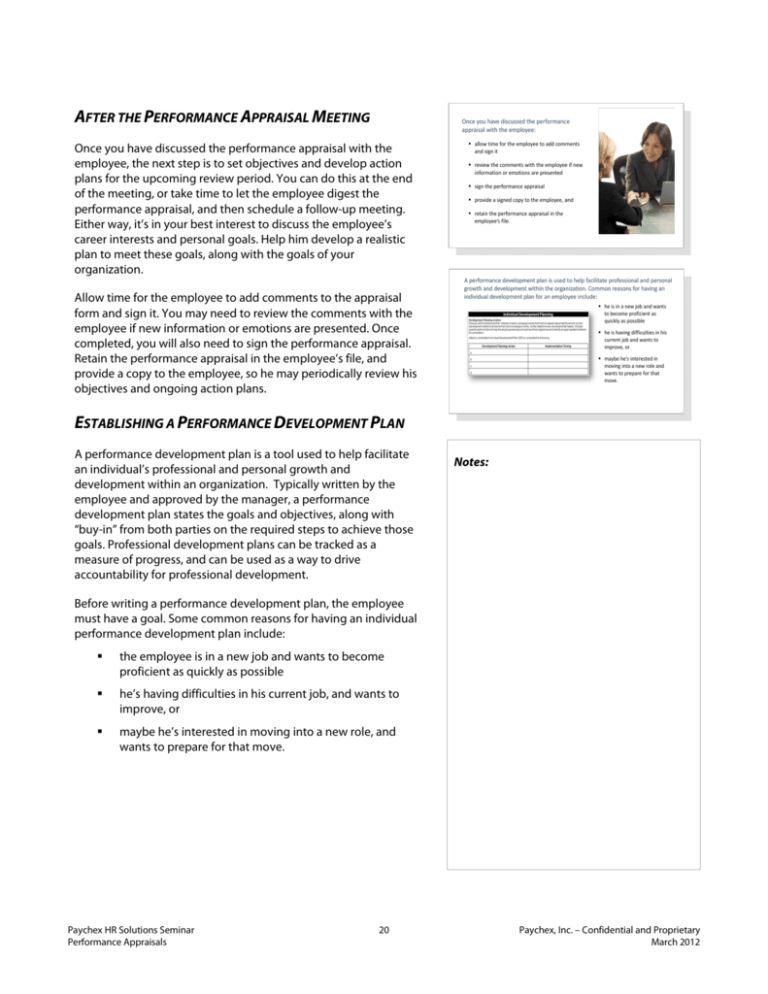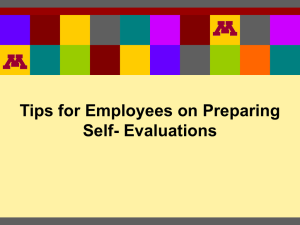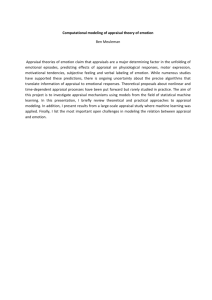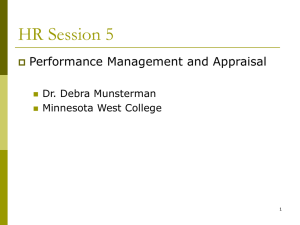Handout
advertisement

AFTER THE PERFORMANCE APPRAISAL MEETING Once you have discussed the performance appraisal with the employee, the next step is to set objectives and develop action plans for the upcoming review period. You can do this at the end of the meeting, or take time to let the employee digest the performance appraisal, and then schedule a follow-up meeting. Either way, it’s in your best interest to discuss the employee’s career interests and personal goals. Help him develop a realistic plan to meet these goals, along with the goals of your organization. Allow time for the employee to add comments to the appraisal form and sign it. You may need to review the comments with the employee if new information or emotions are presented. Once completed, you will also need to sign the performance appraisal. Retain the performance appraisal in the employee’s file, and provide a copy to the employee, so he may periodically review his objectives and ongoing action plans. ESTABLISHING A PERFORMANCE DEVELOPMENT PLAN A performance development plan is a tool used to help facilitate an individual’s professional and personal growth and development within an organization. Typically written by the employee and approved by the manager, a performance development plan states the goals and objectives, along with “buy-in” from both parties on the required steps to achieve those goals. Professional development plans can be tracked as a measure of progress, and can be used as a way to drive accountability for professional development. Notes: Before writing a performance development plan, the employee must have a goal. Some common reasons for having an individual performance development plan include: the employee is in a new job and wants to become proficient as quickly as possible he’s having difficulties in his current job, and wants to improve, or maybe he’s interested in moving into a new role, and wants to prepare for that move. Paychex HR Solutions Seminar Performance Appraisals 20 Paychex, Inc. – Confidential and Proprietary March 2012 ESTABLISHING A PERFORMANCE DEVELOPMENT PLAN – CONT. Notes: The next step is for the employee to identify the most important job competencies needed to achieve the goal. Your role, as a manager, may be to help identify those competencies and the necessary actions, which might include formal training classes, coaching or mentoring, shadowing a teammate, or taking on additional responsibilities outside the scope of his current job. Once the actions are documented, you can assist the employee with assigning dates, costs, and accountability to each of the actions identified. The dates will help you track progress, and you will need to approve any costs. Both you and the employee should sign the performance development plan, as a two-way commitment that you both will put forth the effort to achieve the desired outcome. Paychex HR Solutions Seminar Performance Appraisals 21 Paychex, Inc. – Confidential and Proprietary March 2012 COMMON ERRORS AND LEGAL CONCERNS While preparing the performance appraisal, there are several potential pitfalls to avoid. COMMON PERFORMANCE APPRAISAL ERRORS Mistakes can be linked to the performance appraisal process itself, or to the person conducting the performance appraisal. Being aware of some of these common errors can help you be more effective and avoid potential problems. No formal policy or process for conducting performance appraisals. Following a written policy that details the appraisal process will help ensure consistency, which may ultimately provide protection against claims of negligence or wrongful discharge. Inadequate rating system. A performance appraisal form that is too complex may lead to misrepresentation and misuse of the rating tool. Use of subjective criteria may result in discriminatory performance reviews. Imprecise measurement systems can make it difficult to distinguish between performance levels. Inappropriate time spans. It’s important to look at the entire review period when evaluating employees. Using only recent events or incorporating incidents that occurred during the previous review period may be considered unfair and may result in lowered employee morale or possible discrimination claims. If a performance gap from a previous review period remains uncorrected, it should continuously be addressed through the company’s progressive discipline policy. Late performance reviews. Many employers conduct performance appraisals annually. However, when balancing workplace demands, performance appraisals sometimes end up at the bottom of the list. Unfortunately, the message to the employee is clear – he’s really not that valuable of an asset if you can’t take the time to evaluate his performance. Late appraisals can also lessen a manager’s credibility. How can you expect employee’s to meet deadlines if you can’t meet them yourself? Paychex HR Solutions Seminar Performance Appraisals 22 Notes: Paychex, Inc. – Confidential and Proprietary March 2012 COMMON PERFORMANCE APPRAISAL ERRORS – CONT. Waiting for the performance appraisal meeting to discuss performance. Although you’re using data for the entire review period, it’s not a good idea to wait until the review to provide feedback to the employee about his performance. The performance appraisal meeting is not the time for surprises! Inconsistency. Apparent inconsistency can rob the appraisal process of its legitimacy. It can also increase the risk of discrimination claims. Notes: Being aware of common errors can help the performance appraisal process go smoothly and be more productive. However, you, as the manager, can also contaminate the review by falling prey to any of the following: Inadequate observation. It’s important that the manager writing the performance appraisal works closely with the employee and knows what his key job responsibilities are. Halo effect. This occurs when managers let one strong positive value judgment in one area color their judgment in other areas. On the flipside, the horns or pitchfork effect occurs when managers let one strong negative value judgment influence their judgment in other areas. Bias errors. These occur when a manager’s values or prejudices affect his ability to appraise performance objectively. Bias errors can occur when a manager: – makes a snap judgment based on a first impression and ignores or distorts the employee’s actual performance – favors employees whom they perceive to be similar to them – assumes that senior employees perform at or above the expected levels because they are more experienced, or – feels his employees are not entitled to a higher performance rating than he received. Stereotyping. Similar to bias errors, stereotyping can qualify as a form of unlawful discrimination. Leniency or strictness errors. This occurs when a manager is reluctant to hurt an employee’s feelings or hurt them financially (leniency error). Or, in contrast, some h li ti t ti b t Paychex HR Solutions Seminar Performance Appraisals 23 Paychex, Inc. – Confidential and Proprietary March 2012 COMMON PERFORMANCE APPRAISAL ERRORS – CONT. Notes: Central tendency error. This occurs when managers avoid giving very high or very low ratings, since they require more accountability. This may also happen if the manager is uncomfortable with the control they perceive to have over their subordinates’ careers, thereby rating everyone as “satisfactory” (or meets expectations). Contrast error. This occurs when the manager’s rating of an employee is influenced by the exceptional performance (good or bad) of others. Avoiding negative feedback. This occurs when managers are uncomfortable giving negative feedback. However, employees need constructive criticism with concrete examples to improve and develop their skills appropriately. A glowing review of a mediocre or poor performer can be problematic later, if you terminate or otherwise discipline that employee. Paychex HR Solutions Seminar Performance Appraisals 24 Paychex, Inc. – Confidential and Proprietary March 2012 LEGAL CONCERNS One of the most important reasons to learn how to effectively write and deliver performance appraisals is to reduce the potential for lawsuits by employees. Although there are no laws governing how, when, or even if performance appraisals need to be conducted, they offer a long-term benefit if done accurately, consistently, and timely. Inconsistent performance appraisals that are poorly written, or poorly conducted, may put your company in jeopardy of costly litigation. However, accurate job-related performance documentation can be an employer’s best justification for an employment decision and a defensible record in claims of: Discrimination – employment decision-making or working conditions that are advantageous (or disadvantageous) to members of one group compared to members of another group. Defamation – a false statement that damages a person’s reputation by inference, made with malice, and results in injury. Claims of Negligence – an employer may be judged negligent if he failed to warn an employee that discharge was likely. You may be held liable if written or verbal promises were not kept, or if performance appraisals were not completed according to company policy. Wrongful Discharge – In most states, employment relationships that are not controlled by a collective bargaining agreement or another written contract are considered “at-will.” The risk for wrongful discharge claims can remain where employers make explicit or implicit promises for continued employment. Paychex HR Solutions Seminar Performance Appraisals 25 Notes: Paychex, Inc. – Confidential and Proprietary March 2012 SUMMARY During this training, we discussed the performance appraisal process, including: the benefits of having a performance appraisal process defining job requirements establishing performance standards monitoring performance writing the performance appraisal, and conducting the performance appraisal meeting. Notes: In addition, we talked about common errors and potential legal concerns when writing and delivering performance appraisals. Although conducting a thorough performance appraisal takes time, the rewards can be substantial. On the other hand, performance appraisals that are poorly written, or poorly conducted, may put you in jeopardy of costly litigation. You can help reduce exposure to legal actions by maintaining accurate records and basing performance appraisals on specific, objective, job-related behaviors. Paychex HR Solutions Seminar Performance Appraisals 26 Paychex, Inc. – Confidential and Proprietary March 2012 Paychex® HR Solutions Client Seminar Information for Managers and Supervisors Performance Appraisals Paychex HR Solutions The single source for HR, benefits, and payroll processing. 3/12 152491








